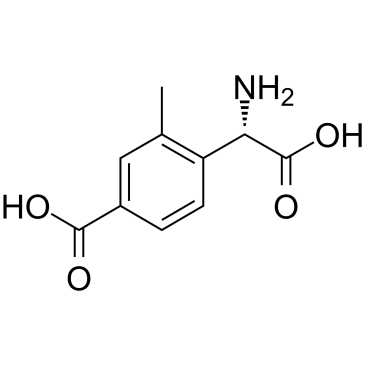198419-91-9
| Name | 4-[(S)-amino(carboxy)methyl]-3-methylbenzoic acid |
|---|---|
| Synonyms |
Tocris-1237
(S)-(+)-a-amino-4-carboxy-2-methylbenzeneacetic acid |
| Description | LY367385 is a highly potent and selective mGluR1a antagonist. LY367385 has an IC50 of 8.8 μM for inhibits of quisqualate-induced phosphoinositide (PI) hydrolysis, compared with > 100 μM for mGlu5a. LY367385 has neuroprotective, anticonvulsant and antiepileptic effects[1][2]. |
|---|---|
| Related Catalog | |
| Target |
mGluR1a:8.8 μM (IC50) |
| In Vitro | LY367385 combined with N-methyl-D-aspartate (NMDA) during the toxic pulse attenuates neuronal degeneration in a concentration-dependent fashion, with a maximal reduction of NMDA toxicity ranging from 40 to 60%. LY367385 shows greater efficacy than LY367366 and neither of these compounds influenced neuronal viability per se. LY367385 shows potent neuroprotective effects, with causing a 50% reduction in (S)-3,5-Dihydroxyphenylglycine (DHPG) potentiation at a concentration of 10 nM. Under experimental conditions at higher concentrations of antagonist, LY367385 a completely antagonized the amplification of NMDA toxicity by DHPG[2]. |
| In Vivo | LY367385 has been administered intracerebroventricularly (i.c.v.) to DBA/2 mice and lethargic mice (lh/lh), and focally into the inferior colliculus of genetically epilepsy prone rats (GEPR). In DBA/2 mice, LY367385 produces a rapid, transient suppression of sound-induced clonic seizures ED50 = 12 nM, i.c.v., 5 min). In lethargic mice, LY367385 significantly reduces the incidence of spontaneous spike and wave discharges on the electroencephalogram, from 30 to >150 min after the administration of LY367385, 250 nM, i.c.v[3]. In genetically epilepsy prone rats, LY367385 reduces sound-induced clonic seizures. LY367385, 160 nM bilaterally, fully suppresses clonic seizures after 2-4 h[3]. |
| References |
| Molecular Formula | C10H11NO4 |
|---|---|
| Molecular Weight | 209.19900 |
| Exact Mass | 209.06900 |
| PSA | 100.62000 |
| LogP | 1.47790 |
